Dec 30, 2025
Dec 30, 2025
Weekend Rendezvous in the Black Buck National Park, Bhavnagar
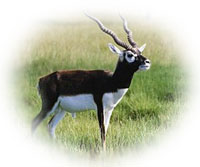 Early one Saturday morning last winter armed with cameras and a packed picnic lunch we set out to visit our wild neighbors, the majestic Black Bucks. The first sight that greeted our eyes, after taking the left turn on the highway as we drove down 10 Kms. through the narrow approach road that cuts across the national park is the wide expanse of tall, dry golden savannah grass blowing in the wind- it is as if our eyes encounter a sea of gold with herds of wild fauna-the black bucks, antelopes or nilgais grazing like studded gems, their lissome, lithe bodies soft, lustrous and glistening like velvet in the sun, at peace with their world.
Early one Saturday morning last winter armed with cameras and a packed picnic lunch we set out to visit our wild neighbors, the majestic Black Bucks. The first sight that greeted our eyes, after taking the left turn on the highway as we drove down 10 Kms. through the narrow approach road that cuts across the national park is the wide expanse of tall, dry golden savannah grass blowing in the wind- it is as if our eyes encounter a sea of gold with herds of wild fauna-the black bucks, antelopes or nilgais grazing like studded gems, their lissome, lithe bodies soft, lustrous and glistening like velvet in the sun, at peace with their world.
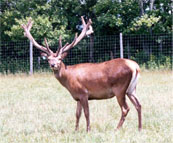 Sometimes in the early morning or late evening, the colorful 'Kathi' cowherds and shepherds adorned in homespun, heavily embroidered kareya-chauni and traditional jewellery mingle naturally with the scene as they herd their oxen through the winding narrow expanse. Their cries to their animals an eternal assurance that life, in this sanctuary at least, is as it always was, always have been ' safe, secure and peaceful. The cool and refreshing morning breeze, the reddish black earth, the wide expanse of flat, open grasslands teeming with gold, the grazing fauna, the sudden flights of birds, the tinkle of the cowbells, the shrill cries of the cowherds, all add to the panorama of serenity and timelessness in the lap of nature.
Sometimes in the early morning or late evening, the colorful 'Kathi' cowherds and shepherds adorned in homespun, heavily embroidered kareya-chauni and traditional jewellery mingle naturally with the scene as they herd their oxen through the winding narrow expanse. Their cries to their animals an eternal assurance that life, in this sanctuary at least, is as it always was, always have been ' safe, secure and peaceful. The cool and refreshing morning breeze, the reddish black earth, the wide expanse of flat, open grasslands teeming with gold, the grazing fauna, the sudden flights of birds, the tinkle of the cowbells, the shrill cries of the cowherds, all add to the panorama of serenity and timelessness in the lap of nature.
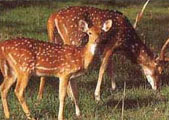 Suddenly the stillness, the indolence of the scene is broken by a leap out of the gold- two frolicking fawns in pursuit of each other. The excitement builds as we spot a herd of majestic blackbucks coursing the golden pastures and catch a glimpse of the beautiful albino among them! As our 'homely' visit turns into an adventure we wait with bated breath to experience the myriad emotions that this sanctuary has in store for us.
Suddenly the stillness, the indolence of the scene is broken by a leap out of the gold- two frolicking fawns in pursuit of each other. The excitement builds as we spot a herd of majestic blackbucks coursing the golden pastures and catch a glimpse of the beautiful albino among them! As our 'homely' visit turns into an adventure we wait with bated breath to experience the myriad emotions that this sanctuary has in store for us.
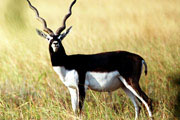 The Velavadar Black Buck National Park, 65km north of Bhavnagar, in the Bhal region of Saurashtra, Gujarat is the home of the majestic Indian antelope. Hugging the sea coasts of the Gulf Of Khambhatt (Cambay) on the south, surrounded by wastelands and agriculture fields on the northern side, and set between two rivers, the park is spread over an area which was primarily a "vidi" (a private grassland) of the Maharaja of the ex-princely state of Bhavnagar. During the rule of the Maharajahs of Bhavnagar, Velavadar was harvested for grass to feed the royal cattle herds and the antelope was traditionally protected by the Kathi community in Gujarat. The only tropical grassland in India to be given the status of a national park, Velavadar National Park is a 36 sq.km. patch of Savannah type grasslands and thorn scrub. The rich soil is believed to have origins in the sea. Its semi-arid conditions, together with overflowing of sea water from the high tidal zone of the Gulf of Khambhat in the southern border of the park during monsoon create habitats for the varied fauna. The Park has areas of dense grasslands, sparse grasslands, shrubland, saline lands and high tidal mudflats. Thirty-nine species of grasses and 46 species of sedges, shrubs and trees, short and medium, represent the diversity of flora. Flat land, dry grasses and herds of antelopes have always attracted visitors to this park.
The Velavadar Black Buck National Park, 65km north of Bhavnagar, in the Bhal region of Saurashtra, Gujarat is the home of the majestic Indian antelope. Hugging the sea coasts of the Gulf Of Khambhatt (Cambay) on the south, surrounded by wastelands and agriculture fields on the northern side, and set between two rivers, the park is spread over an area which was primarily a "vidi" (a private grassland) of the Maharaja of the ex-princely state of Bhavnagar. During the rule of the Maharajahs of Bhavnagar, Velavadar was harvested for grass to feed the royal cattle herds and the antelope was traditionally protected by the Kathi community in Gujarat. The only tropical grassland in India to be given the status of a national park, Velavadar National Park is a 36 sq.km. patch of Savannah type grasslands and thorn scrub. The rich soil is believed to have origins in the sea. Its semi-arid conditions, together with overflowing of sea water from the high tidal zone of the Gulf of Khambhat in the southern border of the park during monsoon create habitats for the varied fauna. The Park has areas of dense grasslands, sparse grasslands, shrubland, saline lands and high tidal mudflats. Thirty-nine species of grasses and 46 species of sedges, shrubs and trees, short and medium, represent the diversity of flora. Flat land, dry grasses and herds of antelopes have always attracted visitors to this park.
The principal attraction of the park is the massive population, the largest in the country, of blackbuck, the handsome Indian antelope, seen here in numbers running into thousands. Rated among the most elegant antelopes and fastest long-distance runners (90km or 58 miles per hour), the exclusive Indian Blackbuck is one of the most graceful and beautiful animal of its kind. The males are black and white with a white ring around the eyes and ringed horns that have a spiral twist of three to fours turns and are up to 70 cm long. The light brown female is usually hornless. The fauna of the park comprises mainly of Blackbuck, Antelope, Wolf, jackal and endangered species of birds. Velavadar is also one of the few places in the world where the wolf is proliferating in India, indeed the world, though they are rarely seen in the daylight. The wolves and the jackals are the prime predators of Velavadar national park. Wolves here use shrub land for lying-up, denning and for rendezvous and depend on blackbuck, hare and other small animals as their prey. Other mammals like nilgais, jungle cat, hyena, wild pig, wild boars, hare, Indian fox and rodents are more easily seen on the periphery. Rarities include the bush cat. All these animals can be viewed on the open flat grassland from very close range. The best time for viewing is early in the morning and dusk. The best time to visit the park is from October to June. The park is closed during the monsoons.
The Park is very rich in birdlife as well. The climate in Velavdar makes it one of the best places for the migrating birds to breed. Excellent for birding, a large number and variety of birds flock here making the birdlife extensive. Velavadar is an excellent place to see a large number of endangered birds like Houbara Bustard, Lesser Florican, Common Cranes, Sarus White Storks, White Pelican, Montagu, Pallid Harriers, Marsh and other raptors including the steppe, tawny, Greater and lesser Spotted Eagle, juvenile Imperial Eagle, Bonelli's Eagle, Short-toed Snake Eagle and white-eyed and Long-legged Buzzard. Chestnut-bellied and spotted Sandgrouse, Painted and Grey Francolin, Demoiselle, Quail, passerines, Sirkeer malkoha, rufous-tailed, crested and sykes' larks, red-rumped swallows, desert and variable wheatears are frequently sighted and many raptors visit specially laggar falcon, hobby, common kestrel, red-necked falcon, peregrine falcon, black-shouldered kite, shikra, Eurasian sparrow-hawk and occasionally northern goshawk. Massive roosts of montagu, pallid and marsh harrier and other grasslands dwellers are seen in fair numbers.
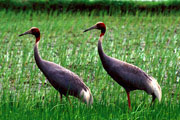 Another rare sight is that of the lesser florican who migrate here and settle here be breed in the grasslands during the rainy season. The male bird attracting the female is an unusual sight to watch. The male bird first marks its territory and then begins the courtship display which is a spectacular vertical leap up to a height of two meters, and which may be repeated over 500 times in a day. Sarus cranes also
Another rare sight is that of the lesser florican who migrate here and settle here be breed in the grasslands during the rainy season. The male bird attracting the female is an unusual sight to watch. The male bird first marks its territory and then begins the courtship display which is a spectacular vertical leap up to a height of two meters, and which may be repeated over 500 times in a day. Sarus cranes also
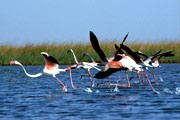 regularly breed in the park during the monsoon season. This place has earned popularity as the largest roosting ground for four species of migratory harriers in the entire world. The Harrier roost here, one of the largest in the world, reaches impressive proportions - more than 2000 birds have been seen at a single site on a winter evening!
regularly breed in the park during the monsoon season. This place has earned popularity as the largest roosting ground for four species of migratory harriers in the entire world. The Harrier roost here, one of the largest in the world, reaches impressive proportions - more than 2000 birds have been seen at a single site on a winter evening!
This unique grassland ecosystem, a biotic province of semi-arid bio-geographical zone, has a successful conservation program of the endangered Blackbuck, the Wolf and an exclusive Indian species, the Lesser Florican (a bustard) among others. As dusk descends on exquisite Velavadar, the wonderful day sadly comes to an end, and worldly affairs press us to return home to civilization, albeit unwillingly. The memory of this lovely little sanctuary absolutely unperturbed by grating urbanizations and showcasing the exquisite beauty of wild Nature remains forever etched in our minds compelling us to visit its wonders again and again.
Velavadar Black Buck National Park
Place: Bhavnagar District, Gujarat
Nearest Town: Ballavpur (32 km)
Best time to visit: Between October and June
Main Attraction: Black Buck
How to get there
Air: Nearest airport is Bhavnagar (72 kms).
Rail: The Nearest Railway station is Dhola (52 kms) and Bhavnagar (72 kms)
Road: The Nearest bus station is Vallabhipur (32 kms). The park is about 72 Kms from Bhavnagar, 315 kms from Rajkot, 170 kms from Ahmedabad. There are buses to the park from Bhavnagar and Vallabhipur. To have a car to drive around the park, one must hire it in Bhavnagar. It is also required to hire a guide at the park gate. There are separate fees for Entry, Camera or Vehicle.
Accommodation
Boarding and lodging facilities are available in the rest house of the Forest Department, Kaliyar Bhavan Forest Lodge, situated near the National Park. Reservation at the tourist lodge can be availed by writing in advance to the Assistant Forest Conservator, Velavadar Black Buck National Park, Velavadar. P.O. Vallabhipur, Bhavnagar. Phone: 0278 428644.
20-Aug-2006
More by : Dr. Sutapa Chaudhuri